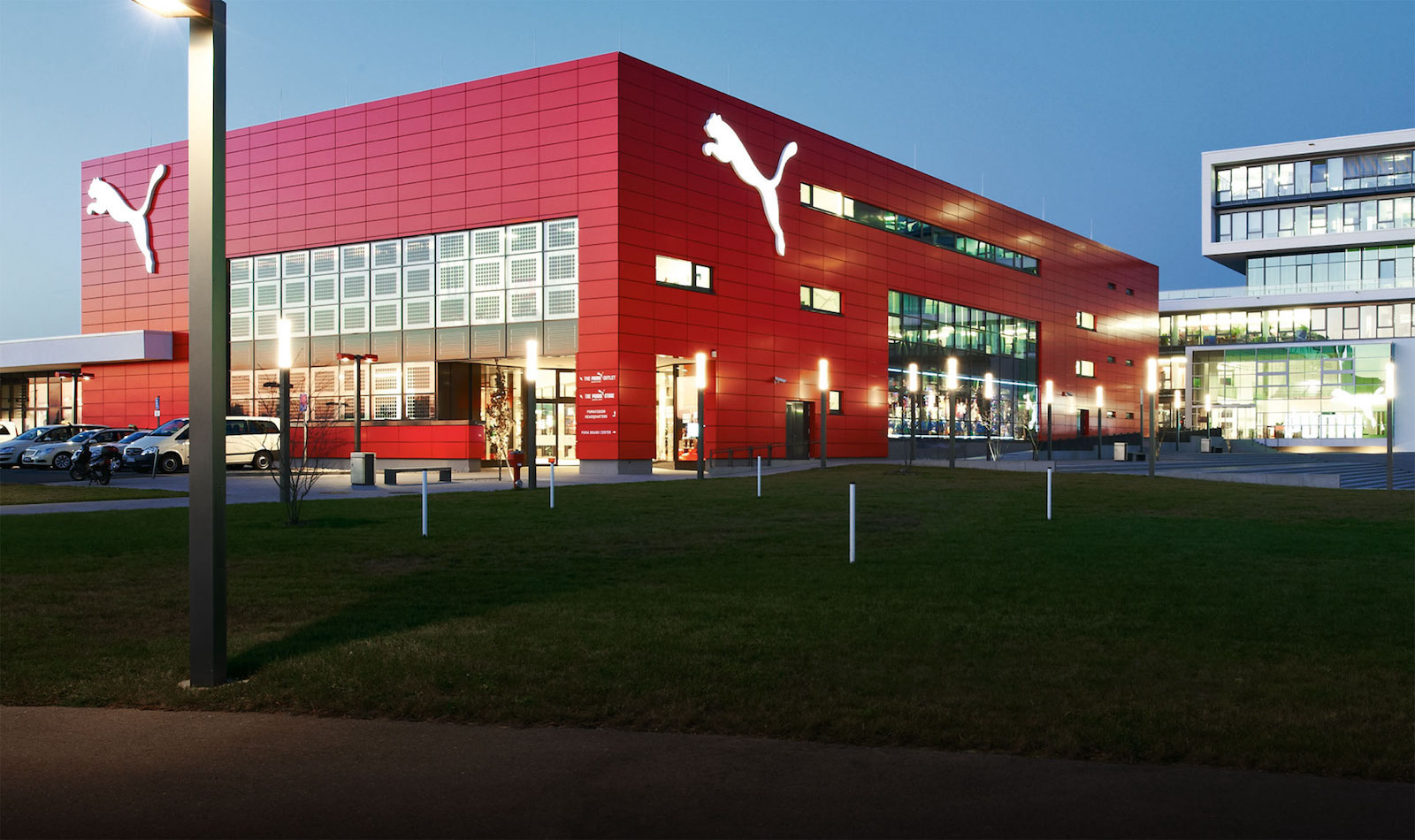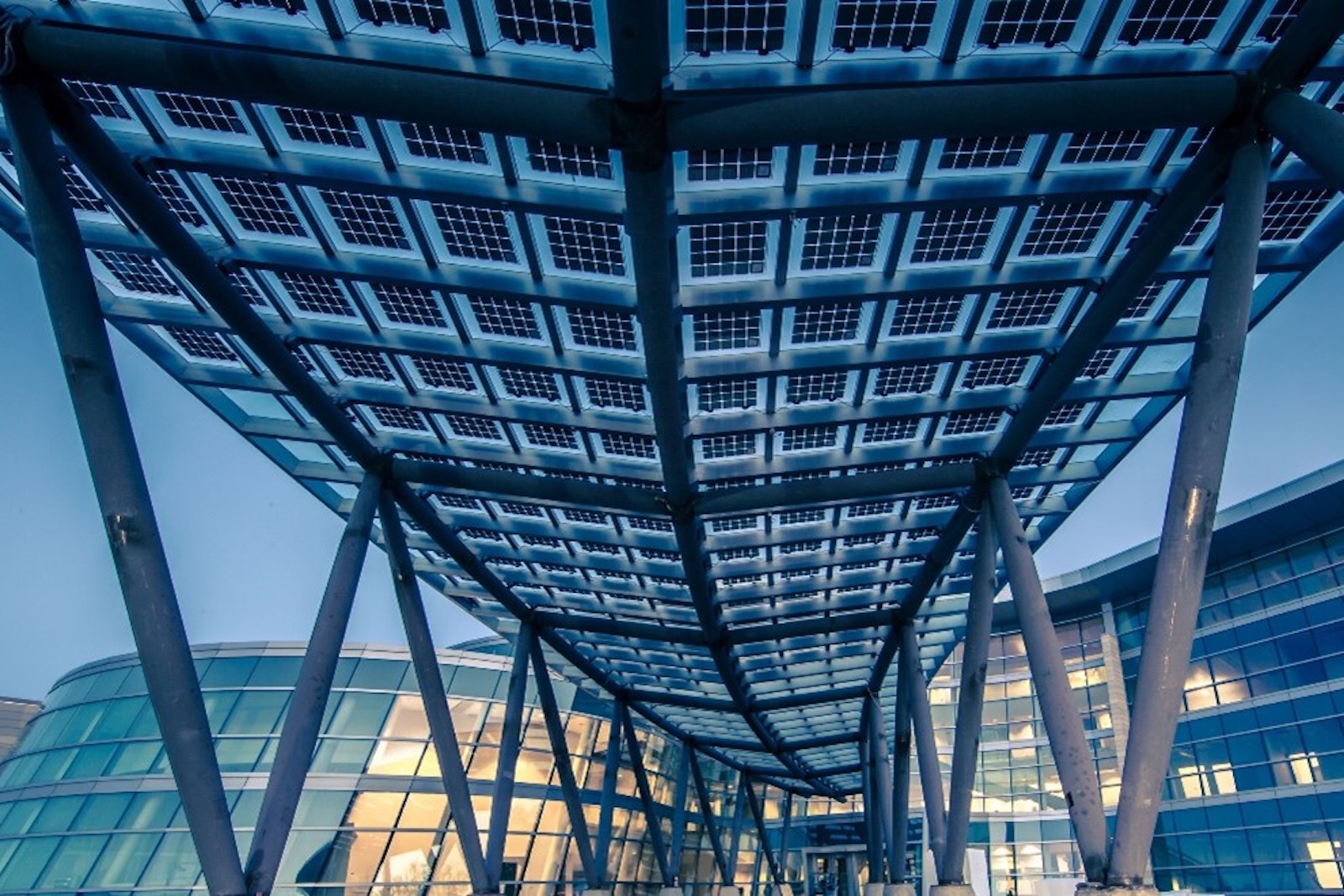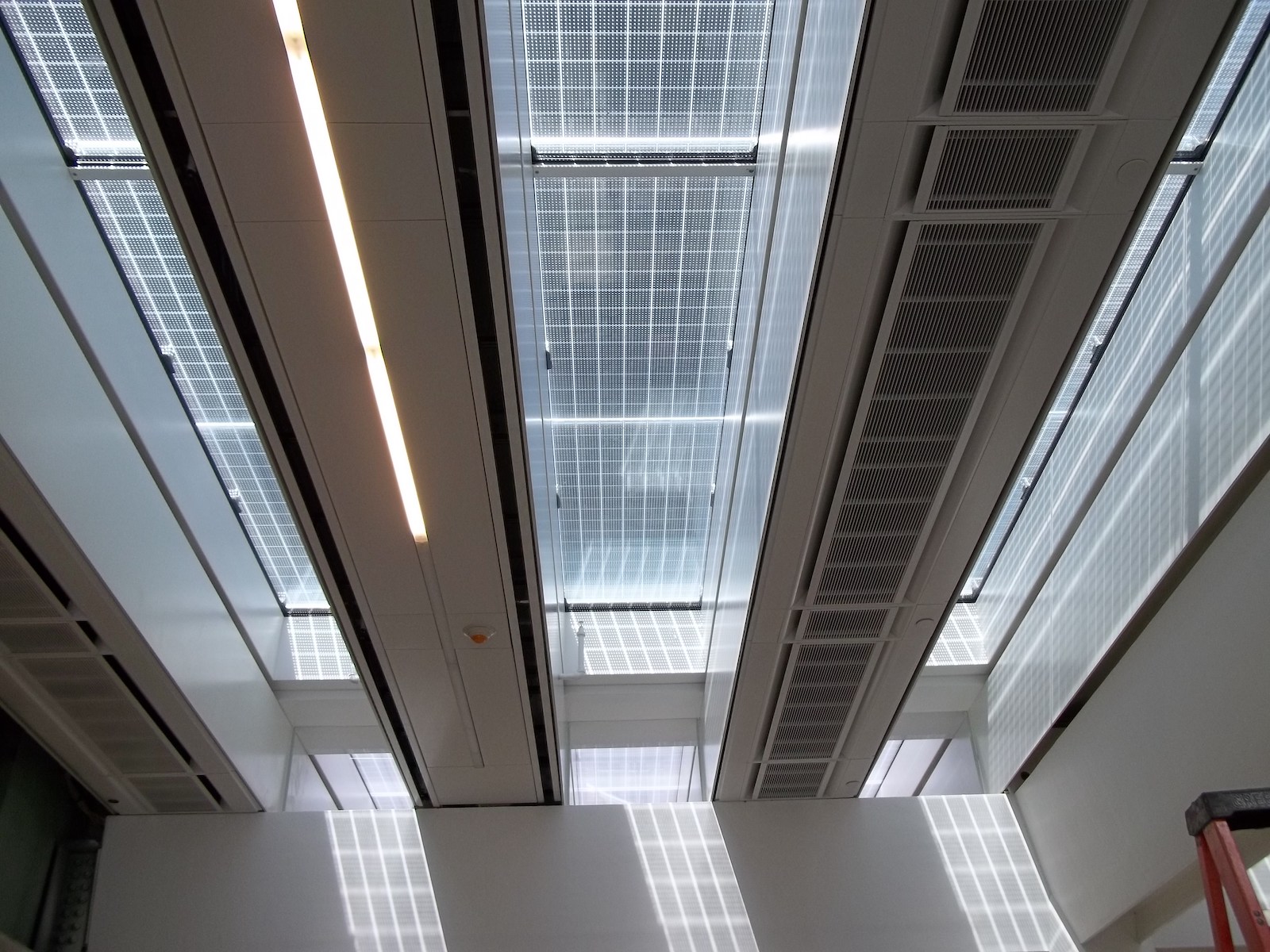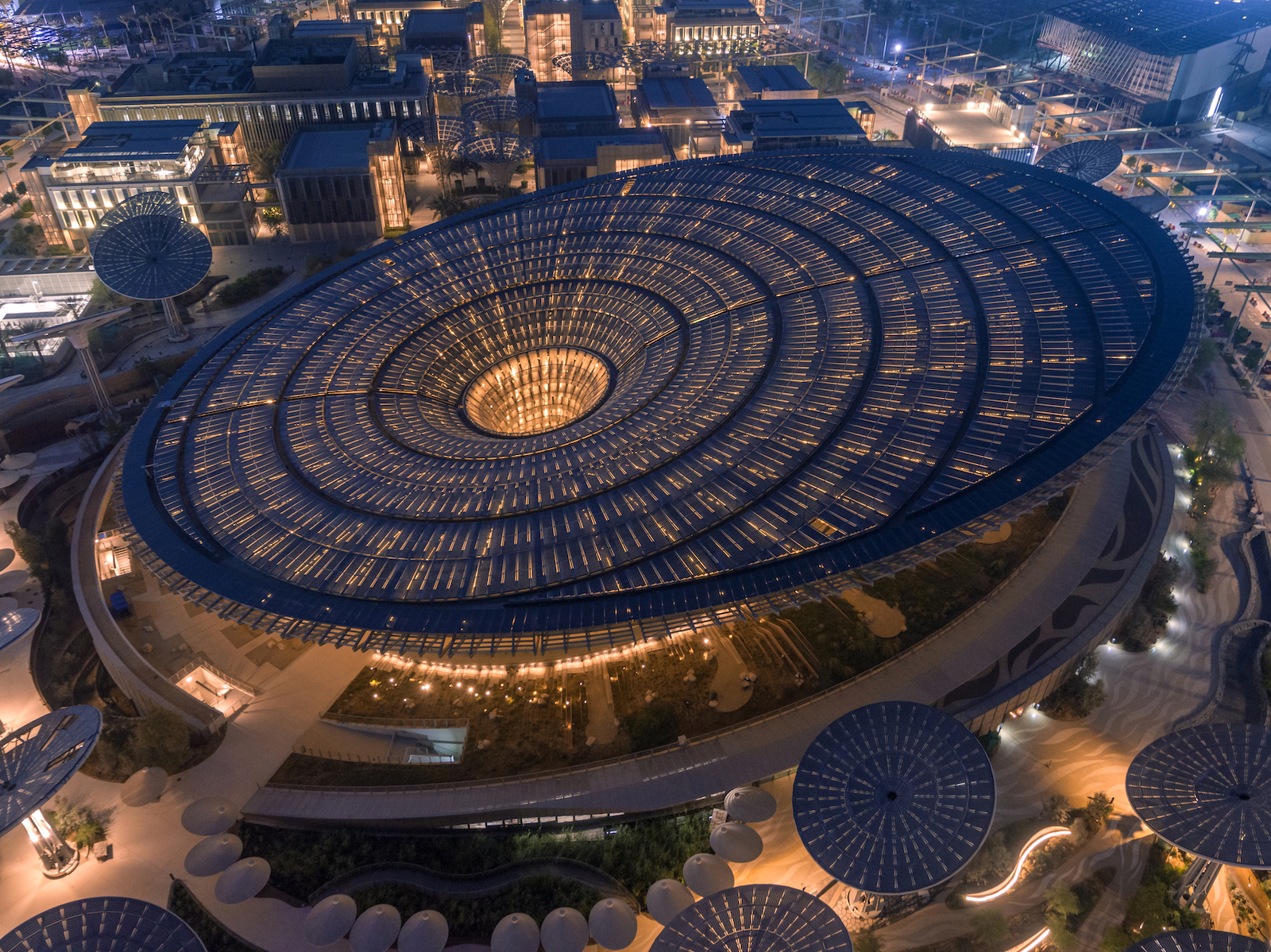Increasingly, building teams are comparing the use of building-integrated photovoltaic (BIPV) systems for façades, roofs, and other architectural assemblies with a promising and much easier alternative: conventional solar panel arrays, either on their building or off-site, to supplement their resiliency and decarbonization efforts. Recent examples include a tech company headquarters in Silicon Valley and a university in Arizona. In both cases, the project teams chose to expand their solar farms in nearby locations rather than use integrated PV technologies.
A growing group, however, is working harder. They are making BIPV an integral part of their latest green building works, contributing to a market expanding at about 15 percent per year. From the cascading glass skylights at the Edmonton Convention Center and the PV roof array overhanging the Bullitt Center in Seattle, to the new curved pavilion created for Dubai Expo and the modern PV façade at the University of Washington, creative applications generating ample electric loads are found worldwide, according to maker Onyx Solar.
“BIPV applications are challenging, and location and context are key to their early evaluations,” says John Ivanoff, an Associate Principal with Buro Happold’s façades and specialty structures team. “Arizona has more sunny days than Alaska or Maine. In some cities, there are recent code changes, such as in New York, where if the roof exceeds a certain area, the project team is required to evaluate the use of PV on the building.”
In urban contexts, neighboring buildings may cast excessive shadows, so the site itself is another aspect of the analysis, adds Ivanoff, who has worked on various innovative BIPV projects including Terra – The Sustainability Pavilion, which opened to the public in 2021 as one of the top three attractions of the Expo 2020 Dubai, UAE.
“BIPV is a challenge because the solar panels work best when on a slight angle, and vertical glass applications don’t always harness the sun in a direct enough way,” says Mark Rhoads, AIA, LEED AP, Associate Principal with Grimshaw, the architecture firm that designed Terra. “So the biggest challenges arise in applying BIPV to non-roof conditions.”
When Grimshaw and Buro Happold collaborated on Dubai’s Sustainability Pavilion, the recently completed educational venue for the client, Expo 2020 Dubai, the stakes were high. Promoting ecology, sustainable technologies, and green design, the project’s core building offers 86,000 sf of exhibition space that includes an auditorium, courtyard, and reservoir. “Soaring over the courtyard, the pavilion’s canopy accommodates more than 64,600 sf (6,000 sm) of ultra-efficient monocrystalline photovoltaic cells embedded in glass panels,” according to Grimshaw’s design team. “The combination of the cell and the glass casing allow the building to harness solar energy while providing shade and daylighting to the visitors below.”
Drawing inspiration from complex natural processes like photosynthesis, the deployable freestanding shade structures are constructed from steel and complex composites, structurally optimized to support an 18-meter photovoltaic array to harvest solar energy. Like a sunflower, the array rotates 180 degrees to follow the sun throughout the course of the day, maximizing energy yield and boosting solar cell efficiency. The bespoke trapezoidal panels employ highly efficient monocrystalline PV cells, embedded within three layers of glass, providing shade below without casting severe shadows or blocking views to the sky.
THE LATEST IN BIPV TECHNOLOGY


Monocrystalline solar cells represent one of four basic BIPV technologies, according to Vitro Solarvolt, a BIPV maker: “It renders a black appearance on solar cells with maximum energy-generation performance, while polycrystalline PV delivers a striking blue appearance with slightly reduced performance,” and it can be less expensive, as well. To provide a patterned appearance and higher visible light transmission (VLT) while retaining some of the energy generation benefits of monocrystalline PV, striped monocrystalline PV offers another option.
Buro Happold’s Ivanoff adds that thin film PV may be suitable for some applications. Thin films require less material, are generally cheaper but result in lower in efficiencies—110-130 peak watts per square meter (Wp/m2) versus 200 Wp/m2 for monocrystalline and 160 Wp/m2 for polycrystalline. Two thin film technologies can be integrated with glass—amorphous silicon (A-Si) and copper indium gallium selenide (CIGS)—and a third, cadmium telluride (CdTe), works for opaque panels. Vitro notes that BIPV glass panels can be used with spandrel glass, as well as low-emissivity (low-e) coatings and glass substrates, including tinted glass. Printed glass shingles are also well-established on the market, says Ivanofff, with surfaces that may be printed to look like other materials such as with a faux brick finish. Customized colored glass, he adds, is increasingly attractive to building teams.
Both Rhoads and Ivanoff stress that glass safety and fire performance should be considered, especially in horizontal and angled applications: “These are electronic elements, and in the UK, the Netherlands, and some U.S. jurisdictions it is regulated for fire safety,” says Rhoads. “Overheating is another issue in operations.” In addition to glass panels, other ways to integrate BIPV include vertically mounted high-performance panels, PV-covered louvers or shades—if those offer sufficient surface area—and street furniture integrated with PV panels, such as the bus shelters and sidewalk shade structures in Los Angeles, Singapore, and some Texas cities, says Ivanoff.

In many cases, however, skylights are seen as the ideal BIPV armature. The pharmaceutical giant Novartis opened its headquarters building a few years ago with the largest BIPV skylight in the world. “The photovoltaic skylight covers 27,500 square feet and consists of hundreds of large transparent photovoltaic glass units developed by Onyx Solar,” according to Power Engineering International, which worked with architect Rafael Viñoly Architects to complete the project. These horizontal and low-slope applications, including roof windows and solar cell covers for simple pedestrian shelters, perform optimally only when maintained well, says Grimshaw’s Rhoads: “Cleanliness is an important consideration. If your cells get covered in dust, the panels lose efficiency exponentially. So maintenance is key to keep them clean,” he explains, noting that the Dubai Expo panels are cleaned almost daily. Ivanoff adds that robotic cleaning systems used in desert solar arrays and on some new towers—along with dedicated maintenance crews—are important players in the drive to optimize efficiencies and yield of PV cells on BIPV systems over the life of the buildings.
In spite of the obstacles, Rhoads expects BIPV applications to expand as the technology becomes more ubiquitous and easy to specify. “These systems create a nice transparent condition,” he says, “and they are as integrated as possible since they power their buildings, bringing us closer to net-zero operations.”
Related Stories
| Aug 11, 2010
Let There Be Daylight
The new public library in Champaign, Ill., is drawing 2,100 patrons a day, up from 1,600 in 2007. The 122,600-sf facility, which opened in January 2008, certainly benefits from amenities that the old 40,000-sf library didn't have—electronic check-in and check-out, new computers, an onsite coffeehouse.
| Aug 11, 2010
BIM school, green school: California's newest high-performance school
Nestled deep in the Napa Valley, the city of American Canyon is one of a number of new communities in Northern California that have experienced tremendous growth in the last five years. Located 42 miles northeast of San Francisco, American Canyon had a population of just over 9,000 in 2000; by 2008, that figure stood at 15,276, with 28% of the population under age 18.
| Aug 11, 2010
Platinum Award: The Handmade Building
When Milwaukee's City Hall was completed in 1896, it was, at 394 feet in height, the third-tallest structure in the United States. Designed by Henry C. Koch, it was a statement of civic pride and a monument to Milwaukee's German heritage. It was placed on the National Register of Historic Places in 1973 and designated a National Historic Landmark in 2005.
| Aug 11, 2010
Great Solutions: Products
14. Mod Pod A Nod to Flex Biz Designed by the British firm Tate + Hindle, the OfficePOD is a flexible office space that can be installed, well, just about anywhere, indoors or out. The self-contained modular units measure about seven feet square and are designed to serve as dedicated space for employees who work from home or other remote locations.
| Aug 11, 2010
Special Recognition: Kingswood School Bloomfield Hills, Mich.
Kingswood School is perhaps the best example of Eliel Saarinen's work in North America. Designed in 1930 by the Finnish-born architect, the building was inspired by Frank Lloyd Wright's Prairie Style, with wide overhanging hipped roofs, long horizontal bands of windows, decorative leaded glass doors, and asymmetrical massing of elements.
| Aug 11, 2010
The pride of Pasadena
As a shining symbol of civic pride in Los Angeles County, Pasadena City Hall stood as the stately centerpiece of Pasadena's Civic Center since 1927. To the casual observer, the rectangular edifice, designed by San Francisco Classicists John Bakewell, Jr., and Arthur Brown, Jr., appeared to be aging gracefully.
| Aug 11, 2010
Great Solutions: Technology
19. Hybrid Geothermal Technology The team at Stantec saved $800,000 in construction costs by embedding geothermal piping into the structural piles at the WestJet office complex in Calgary, Alb., rather than drilling boreholes adjacent to the building site, which is the standard approach. Regular geothermal installation would have required about 200 boreholes, each about four-inches in diameter ...







